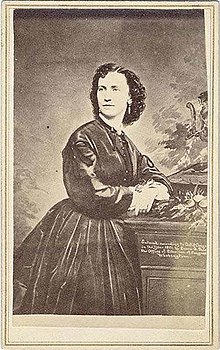Laura Fair
Laura Fair | |
|---|---|
 | |
| Born | 1837 |
| Died | 1837 (aged 82) |
| Known for | murdering her lover |
| Spouse(s) | 1.? 2.? William D. Fair |
| Partner | Alexander P. Crittenden |
| Children | one |
Laura D. Fair (1837–1919) was an American murderer whose death sentence was overturned.
Early life
Laura Fair was born in Holly Springs, Mississippi in 1837. She married her first husband, an alcohol dealer from New Orleans, in 1853 at 16 years old. He died in 1854 and she started school at the Convent of Visitation to become a teacher. Fair left school in a year to remarry but shortly abandoned him to join her mother operating a boarding house in San Francisco. Fair met her third husband, Attorney William D. Fair after moving to Shasta, California. Three years later, the couple separated and Fair committed suicide leaving Laura to support herself, young daughter, and mother.[1]
Murder and trial
In September 1862, Fair opened the Tahoe House in Virginia City, Nevada on South C Street.[1] In 1863, Fair started a relationship with married lawyer Alexander Parker Crittenden.[2] Initially, he said he was single. Fair eventually learned the truth, and Crittenden promised her he would divorce his wife, Clara Churchill Jones.[3]
In 1870, Clara took a transcontinental train to the East Coast and back with her two youngest children. Fair learned that Crittenden was to meet his wife in Oakland and aboard a ferry back to San Francisco. On November 3, 1870, Fair caught the same ferry and shot Crittenden in the heart.[3][4][5]
In April 1871, Fair faced her first murder trial where she claimed that the shooting was the result of temporary insanity caused by a severely painful menstrual cycle. The prosecution painted her as a fallen woman who lured Crittenden into bed and warned the jury that they had a moral obligation. While in jail, Susan B. Anthony and Elizabeth Cady Stanton visited Fair to support her. The jury found Fair guilty of murder, and she was sentenced to hang on July 28, 1871.[1][4][6]
Fair's case was appealed with the support of suffragettes, including Emily Pitts Stevens, founder of the California Woman Suffrage Association.[6] The conviction was overturned on the grounds of prejudice.[1] The press, having supported the initial conviction, were decidedly upset, calling the acquittal a "shameful miscarriage of justice."[7] The case furnished some elements of the story of Laura Hawkins in the novel The Gilded Age: A Tale of Today by Mark Twain and Charles Dudley Warner.[8]
Death
Fair died in 1919, at the age of 82, in San Francisco. Her body was buried in an unmarked grave.[6]
In popular culture
The CBS radio program Crime Classics dramatized the case in an episode entitled "The Incredible Trial Of Laura D. Fair" that aired on August 17, 1953.[9]
References
- ^ a b c d Goldman, Marion S. (1981-01-01). Gold Diggers & Silver Miners: Prostitution and Social Life on the Comstock Lode. University of Michigan Press. ISBN 0472063324.
- ^ "A Woman Scorned? | Origins: Current Events in Historical Perspective". origins.osu.edu. Retrieved 2016-10-21.
- ^ a b "Crittenden family papers 1837–1907". quod.lib.umich.edu. Retrieved 2016-10-21.
- ^ a b "The case of Laura Fair, San Francisco 1870". SFGate. Retrieved 2016-10-21.
- ^ "Crittenden family papers 1837–1907". quod.lib.umich.edu. Retrieved 2016-10-21.
- ^ a b c "The Trials of Laura Fair". www.uncpress.unc.edu. The University of North Carolina at Chapel Hilll. 2016. Retrieved 2016-10-21.
- ^ Public Opinion 1872, p. 522.
- ^ "Afterword" by Greg Camfield to the Oxford University Press edition of The Gilded Age, p. 15.
- ^ [1], accessed January 15, 2020
Bibliography
 This article incorporates text from this source, which is in the public domain: Public Opinion (1872). Public Opinion. Vol. 22 (Public domain ed.). London: Public Opinion.
This article incorporates text from this source, which is in the public domain: Public Opinion (1872). Public Opinion. Vol. 22 (Public domain ed.). London: Public Opinion. {{cite book}}: Invalid|ref=harv(help)
